Of late I’ve lost 16 kilos (35 pounds). Friends look at me with startled wonder, as if they’ve bumped into a unicorn. “You OK?” they say. Since I’m well known for lacking dietary discipline, they figure I’ve come down with a deadly disease.
To their surprise, and mine, I have shrunk the puffy jowls and midriff blubber while still managing to consume at least SOME of what I like — including a beer or two but excluding sweets.
I tell you this because I’m about to write about how very fat we Americans have become. Mere months ago it would have been the pot (belly) calling the kettle black. Now I can wag my finger a bit.
According to the government, one-third of Americans of all ages are not just heavier than what’s considered our ideal weight, we’re obese, making us highly susceptible to killer diseases such as heart attacks, strokes, and diabetes.
Obese. One of those words you don’t want to hear, ranking right up there with “stupid,” “butt ugly,” and “selfish.” With chilling clarity, I remember the first time my doctor used it to describe me. Her mouth said “obese,” but her eyes said, “You’re a slob. Put your clothes on and get out of my sight.”
Americans will own up to being “hefty,” “husky,” “big-boned,” perhaps even “plus-size.” “Obese” means YOU are one of the Fatty Arbuckles the news magazines are writing about in their “obesity epidemic” cover stories.

We protest. We aren’t obese, we say — without much conviction. “Ideal” weight standards are absurd. Mine was something like 73 kg (160 pounds). Ridiculous. At that weight, I’d look like the person in Edvard Munch’s Scream painting. I waddled on, comforting myself that I “carried the weight well.”
So do millions of other Americans as we line up at the trough, “supersizing” already-gluttonous offerings such as triple cheeseburgers, heavily salted French fries, and frosty colored chemicals that whip up into non-dairy “milk” shakes.
The cover of a recent Time magazine health issue showed a chubby boy clutching a gigantic, double-scoop ice-cream cone. The story inside noted that “it’s not just genetics and diet” that are creating a surge in juvenile obesity.
No, wrote Time. Not just genetics and diet but also poverty. Poor kids on remote Indian reservations, for instance, have little access to healthy fruits and vegetables.
Race matters, too. National figures show a 30-percent obesity rate among white kids. The reading is five points higher for black children and eight points higher for Mexican-American youngsters. Fattening foods like tamales and refried beans, cooked in lard, are staples of the Mexican-American diet. And only a relatively small percentage of African Americans live in neighborhoods with well-stocked grocery stores; instead, corner stores peddle sweets and soft drinks and salty snacks.

Click on this to check out the selection of sugary sodas, candy, and baked goods. (Rogelio V. Solis/AP)
One such little store that the Washington Post found near a school in a poor neighborhood sold 640 bags of honey cheese curls, 140 bags of salted potato chips, 240 packages of sugary shortcake rolls, and 2,400 bottles of sweet soda — in just five school days.
Many of its customers skipped the free, healthy school breakfasts and ate this fare as their first meal of every day. Then they crammed in more of this — what’s a polite word? — crud after school, too.
Not just genetics and diet but also environment is fueling Americans’ rotundity. Caucasian children in fitness-conscious towns such as Boulder, Colorado, which is loaded with bike trails and health-food stores, have low obesity levels. Those of us in other, less vigorous towns look like water balloons.
Time also pointed to school drop-out levels, high-calorie foods in school cafeterias and vending machines, reductions in physical-education instruction, and the corrupting influence of techno-gadgets — with which our children are consumed in lieu of romping with friends outside — as contributors to childhood obesity.
Fat kids become flabby, and often prematurely dead, adults. I look at the unpleasingly-plump couples who walk into restaurants with their extra-large kids and think to myself, “Don’t they know better than anyone the miseries that their children have in store?”
We’re a nation on a sugar high. On a recent trip through the South, a couple kept track of the offerings at the quick-in/quick-out stores attached to gasoline stations. Most of these places had not a single apple or banana or carton of low-fat milk. Every shelf was jammed with sugary drinks, fattening sausages and potato chips and candy bars and beer — not to mention cigarettes, cigars, chewing tobaccos, and snuff.
Been there. Seen that. Eaten a lot of it, too.
The couple did find breakfast cereal — sugar-frosted, of course. But the featured breakfast items, right in your face at the check-out counter, were cream-filled donuts and double-sausage biscuits with melted processed cheese.
Even our national treasure called the “state fair” is a gastronomic disaster. I recently wrote about the North Carolina State Fair, which was underway in the capital city of Raleigh, where you could see thousands of piggies — outside the agriculture barns.
Sure, fairgoers could check out lots of exhibits about good nutrition, and sample wholesome farm products made from healthful recipes. Fat chance of that, so to speak.
When they weren’t riding the merry-go-round or trying to win stuffed animals, they were patronizing the concession stands, where we’re not just talking greasy fries, sugary cotton candy, and caramel-dipped apples. Those were low-cal fare compared with other, featured artery-clogging items, deep-fried in lard or oil.
Among the decidedly delicious, anything-but-nutritious, offerings: spicy, deep-fried turkey wings, deep-fried chocolate pie, deep-fried pumpkin pie, and deep-fried chocolate-chip cookies. Somewhere on the grounds, someone was also probably selling the state-fair staple — deep-fried ice cream, and maybe deep-fried pickles.
Notice the “deep-fried” theme?
Customers could try chocolate-covered Twinkie logs. Twinkies are spongy cakes shaped like gold ingots, filled with a sugary cream-like substance. No dairy products in them!
If that didn’t cause a massive letting out of belts, Carolina fair patrons could order-up deep-fried bacon-and-cheese mashed potato bites. Or honey buns, which are rolled dough spread with sugar, nuts and honey, and then — all together now — deep-fried.
And before washing down those selections with sweet lemonade, lots of folks made room for a fried Frito pie. There are already about 500 calories in a small bag of these salty corn chips. Fair concessionaires crunched ‘em up into a pie crust, filled it with who-knows-what, and, of course, fried the whole thing in the ever-present vat of oil.
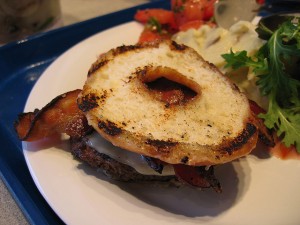
Not just a Krispy Kreme burger. A Krispy Kreme CHEESEburger with BACON. (satanslaundromat, Flickr Creative Commons)
Did I mention the Krispy Kreme burgers? Krispy Kremes are airy doughnuts, already deep-fried and doused with sugary glaze. Put one on each side of a fried burger, and you’ve got a cardiology classic.
We deny, brush off, or don’t even notice the degree of our attraction to such epicurean outrages and blame our busy schedules for the extra kilos around our waists. How could I possibly get out and walk the National Mall each workday, let alone carve out time on a treadmill, with research and writing deadlines ahead of me?
Weekends? Too hot, too snowy, gone before you know it.
Evenings? Right. I’m going to drag in after a long day and terrible commute, throw something together — more likely microwave leftover pizza — and have plenty of energy for a spin on the StairMaster.
Not going to happen.
Just when we are running out of excuses, along comes a handy new villain — other than ourselves:
It’s the very nature of our work.
With less and less industrial activity and more and more use of brainpower, we have planted ourselves in front of computers, and can’t get up! Why, it’s the Information Age that’s made us slouches!
According to a new report in the online scientific journal PLoS One, 80 percent of U.S. jobs now involve no physical activity — or just a bit. Contrast that with the days when we were a country of vigorous stevedores, ironworkers, carpenters, gandy dancers, and miners, and the average American worker burned 130 calories each day, right on the job. Now those calories stay planted in our bodies, often in unflattering places.
It’s not entirely true, to be fair, that we are sedentary statues, glued to our computer screens. We DO get up and about — to grab a large, foamy latte at a coffee bar, and then again to pick up lunch, say at a cafeteria that offers bins of macaroni and cheese, moussaka with parmesan cheese and butter sauce, and puddings in several flavors.
Of course, since we’re newly concerned about obesity, we wash down lunch with a diet soda.
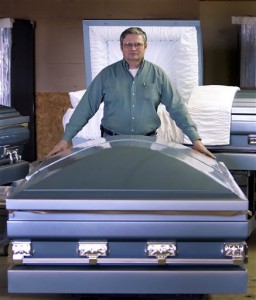
Keith Davis of the aptly named Goliath Casket Co. poses with one of its deluxe, extra-large models. (AP Photo)
As more and more Americans turn tubby, companies are cashing in. We’re building heftier bedsprings and baby strollers, reinforced barstools, elephant-sized underwear — even gigantic caskets. A photograph accompanying an Associated Press story about this trend shows a man standing behind a coffin that looks like a river barge! Instead of the usual 70 centimeters, it’s 132 centimeters wide.
It’s as if our whole society is saying, “I could stand to lose a few pounds, but I’m in shape. Round’s a shape!”
It was my shape until the doctor called me “obese” to my face. But unhealthy choices are no longer my business, and my family’s, alone. They have become a serious national concern. Ask an emergency-room nurse, those who pay insurance claims, or military recruiters who must search high and low for fit young women and men.
I can assure you that it’s more fun being thin. Sort of thin, anyway. I can’t wait to see the look on my doctor’s face next time when I strip to my shorts.
She can call me all sorts of things. But obese won’t be one of them.
Ted's Wild Words
These are a few words from this posting that you may not know. Each time, I'll tell you a little about them and also place them into a cumulative archive of "Ted's Wild Words" in the right-hand column of the home page. Just click on it there, and if there's another word that you'd like me to explain, just ask!
Culinary. Pronounced “CULL-ih-nairy,” the word refers to matters of the kitchen or cooking. Chef-level work is called the “culinary art.”
Fatty Arbuckle. A derogatory expression, used — especially by older Americans who remember the silent-screen actor of that name — to describe obese individuals. Like Oliver Hardy of the Laurel and Hardy film duo, Roscoe “Fatty” Arbuckle made comedic hay out of his considerable girth.
Gandy dancer. A railroad worker. Not engineers and conductors, but those with the hot, sweaty construction and maintenance jobs outside, on the rails. The origin of the term is debated, but one explanation pegs it to the dance-like movements of workers manipulating heavy pry bars that, some say, were called “gandies.”
Moussaka. Though the word comes from the Arabic, this is a Greek baked dish consisting of eggplant, meat in layers, savory spices, and a topping of white sauce.
Snuff. Pulverized tobacco leaves, commonly inhaled through the nose. Hence the close connection between the words “sniff” and “snuff.”

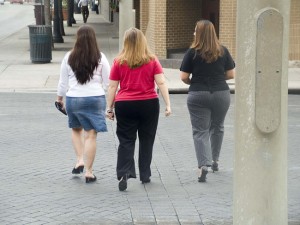

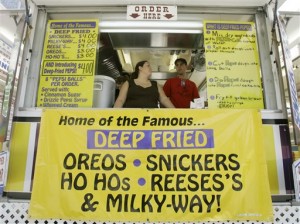
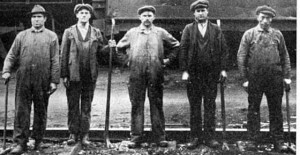

4 responses to “Dealing with the Fat of Our Land”
Dear Friends: Ted is dead-on on this one (LOL). I’ve outlived by thirty years all my old fat colleagues. We Americans have little portion control. That is to say we eat too much. This is aided and abetted by restaurants, food stores and other sources of edibles who sell astonishing quantities of horribly unhealthy food. For example, yesterday I ate at a Chinese restaurant. I was served such a huge portion of food that I was able to take home enough food for several other meals. But I noticed that the other people in the restaurant were eating all the food they were served. The American motto seems to be “Eat a lot! Get fat! Die young!”.
I’m glad that I read this article. The author is right that Americans are too fat and that we make horrible choices in terms of foods and drinks that we consume.
I will have lived in South Korea for almost a year and I’ve seen that the majority of Koreans are in good shape. Most of them have a modest physical size. Some people are bigger, but their rate of obesity seems much smaller than that of Americans.
Koreans tend to eat a lot of grains and vegetables. They eat meat too, but in smaller quantities. They have lots of junk food available too, but it seems that Americans are worse offenders than Koreans.
Dear Aaron,
Reading your comment about South Koreans reminds me of something that I’m experiencing now as a (somewhat) lighter person: Stripping away all the temptations and all the psychological reasons we gravitate to fattening entrees and junk food, I’ve noticed something interesting: Eating choices are a matter of habit as much as anything. Now I’m on a self-imposed, but quite tolerable regimen of a full and satisfying breakfast, a light lunch (mostly of last night’s leftovers), and a reasonable dinner that includes a couple of satisfying beverages. So I don’t feel like I’m being punished. More to the point, I get used to this routine and look forward to each meal. Before, I would double-up servings of the things I liked, put no brakes on portions, and gobbled as much dessert as seemed to satiate me. I wasn’t famished or depressed or consciously hooked on fattening foods. It was just a pleasant routine. Now the less caloric choices are just as much the routine. Perhaps fattening fare laid before your friend in South Korea don’t seem appealing enough for them to drop a diet that satisfies them. I will say, though, doubling back on a thought, that there IS a tremendous psychological element in eating that could use more exploration. Kids have their teddy bears. We have our rocky road.
Thanks for writing.
Ted Landphair
Other than fatty foods, genetic is also another factor. You will see that there are people who no matter how much they eat stay the same. Still slim or skinny. While there is a fat gene, there is also a skinny gene. Our taste buds are conditioned to certain foods. If we always eat sugary foods, we would tend to love what is sweet. This is why when we introduce so call new food, we try to make it as close to the taste buds as possible. You may be eating Chinese food but it is the American version of the Chinese food because the real Chinese food may not be to your liking. Like some people do not like strong garlic. Yet it is one of the most important ingredient in cooking up a Chinese meal. Or whatever international cuisines there are.